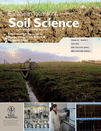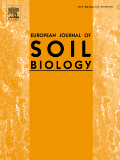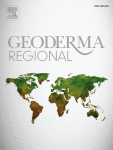
Soil Systems
Scope & Guideline
Pioneering Insights into Soil Health and Ecosystem Dynamics
Introduction
Aims and Scopes
- Soil Health and Quality Assessment:
Research focused on evaluating soil quality indicators, microbial communities, and biochemical properties to understand soil health and its implications for sustainable agriculture. - Soil Management Practices:
Studies on various land use practices, including conservation agriculture, tillage systems, and organic amendments, to improve soil fertility and ecosystem services. - Impact of Environmental Changes on Soils:
Research examining how climate change, pollution, and land use changes affect soil properties, carbon dynamics, and microbial communities. - Soil Remediation and Contamination:
Investigation into methods for remediating contaminated soils, including the use of biochar, phytoremediation, and microbial treatments. - Soil-Ecosystem Interactions:
Exploration of the relationships between soil properties, plant growth, and ecosystem functions, including nutrient cycling and biodiversity. - Innovative Soil Technologies:
Development and assessment of new technologies and methodologies for soil analysis, monitoring, and management, including remote sensing and machine learning applications.
Trending and Emerging
- Climate Resilience and Adaptation:
A surge in research focused on understanding how soils can be managed to enhance resilience against climate change impacts, such as drought and salinity. - Microbial Ecology and Soil Health:
Increased attention on the role of soil microorganisms in maintaining soil health, nutrient cycling, and plant interactions, highlighting the importance of microbial diversity. - Soil Carbon Sequestration:
Growing interest in strategies for enhancing soil organic carbon storage as a means of climate mitigation and improving soil fertility. - Use of Biochar and Organic Amendments:
Emerging research on the application of biochar and other organic amendments for improving soil properties, fertility, and remediation of contaminated soils. - Precision Agriculture and Digital Soil Mapping:
The integration of advanced technologies such as remote sensing, machine learning, and digital mapping techniques to optimize soil management practices and enhance decision-making. - Soil and Water Conservation Techniques:
An increasing focus on practices that promote soil conservation and sustainable water management in agriculture, particularly in the context of water scarcity and soil degradation.
Declining or Waning
- Traditional Soil Fertility Studies:
Research specifically centered on conventional soil fertility practices has decreased as more innovative and integrated approaches gain attention, such as agroecological methods and sustainable intensification. - Single-Factor Analysis of Soil Properties:
There is a waning interest in studies that focus solely on single-factor analyses (e.g., one nutrient or soil property) without considering the complex interactions within soil systems. - Historical Soil Studies:
Research that primarily investigates historical soil data without applying modern analytical techniques or addressing contemporary issues such as climate change impacts is becoming less prevalent. - Soil Physics in Isolation:
Studies focusing solely on soil physical properties without integrating biological or chemical aspects are declining as the field moves towards a more holistic understanding of soil systems.
Similar Journals

EUROPEAN JOURNAL OF SOIL SCIENCE
Pioneering Research in Soil Ecology and ManagementEUROPEAN JOURNAL OF SOIL SCIENCE, published by Wiley, stands as a leading platform in the field of soil science, recognized for its contributions to the understanding of soil ecology, management, and sustainability. With an impressive impact factor and a distinguished Q1 ranking in Soil Science, this journal has recently ranked 23rd out of 159 in its category on Scopus, placing it in the 85th percentile among its peers. Covering a wide array of topics as it converges into the future, from 1994 to 2024, the journal aims to disseminate groundbreaking research and innovative methodologies that address the pressing challenges of soil degradation and environmental sustainability in Europe and beyond. Although it is not an open access journal, the EUROPEAN JOURNAL OF SOIL SCIENCE remains a vital resource for researchers, professionals, and students seeking to deepen their understanding and explore the latest advancements in soil science.

Journal of Soil Science and Plant Nutrition
Unveiling the secrets of soil and plant interactions.The Journal of Soil Science and Plant Nutrition, published by SPRINGER INT PUBL AG, is a premier academic journal dedicated to advancing the fields of agronomy, plant science, and soil science. With an impressive Q1 ranking in both Agronomy and Crop Science and Plant Science, alongside a Q2 ranking in Soil Science, this journal stands at the forefront of innovative research and knowledge dissemination. Annually indexed in key databases, it provides a platform for high-quality research articles that explore the complex interactions between soil health and plant nutrition, contributing significantly to sustainable agricultural practices. Although it does not offer open access options, the journal is accessible through various academic institutions and libraries, ensuring a wide readership. With its emphasis on impactful findings, the journal is an essential resource for researchers, professionals, and students aiming to further their understanding and application of soil and plant science in an ever-evolving global context.

Soil & Environment
Fostering Collaboration for a Greener FutureSoil & Environment is a distinguished open access journal published by the University of Agriculture, Institute of Soil & Environmental Sciences, located in Faisalabad, Pakistan. Established in 2006, this journal has become a vital platform for disseminating pioneering research in the fields of Environmental Science and Soil Science. With an ISSN of 2074-9546, it provides a wealth of knowledge through accessible academic articles, particularly focusing on sustainable practices and innovations that impact soil and environmental health. Although currently categorized in Q4 within both Environmental Science (miscellaneous) and Soil Science, the journal is dedicated to enhancing its influence and visibility as it progresses towards convergence years that span from 2010 to 2024. Researchers, professionals, and students will find Soil & Environment an essential resource for staying informed about the latest developments and methodologies in soil conservation and environmental sustainability. By offering publicly accessible content, the journal aims to foster greater collaboration and knowledge-sharing within the global scientific community.

VADOSE ZONE JOURNAL
Pioneering research at the forefront of soil and water dynamics.Vadose Zone Journal, published by Wiley, is a premier Open Access journal dedicated to advancing research in the dynamic field of soil science, particularly focusing on the vadose zone—the area of soil above the groundwater table that plays a critical role in hydrological processes. Since its inception in 2002, the journal has provided a platform for high-quality, impactful research, reflected in its impressive ranking among the top 25% of journals in the Soil Science category. With an increasing emphasis on sustainable agricultural practices and environmental protection, the Vadose Zone Journal offers invaluable insights and innovative methodologies that cater to the needs of researchers, practitioners, and students alike. Located in Hoboken, NJ, the journal operates on a fully Open Access model since 2018, ensuring that cutting-edge findings are readily accessible to a global audience. Join the community of experts and make significant contributions to our understanding of critical soil processes through this esteemed publication.

CATENA
Uncovering Groundbreaking Insights in GeosciencesCATENA is a distinguished academic journal published by Elsevier, focusing on the critical field of Earth-Surface Processes. With a solid foundation established in 1973, CATENA has continuously evolved, offering a platform for high-impact research and groundbreaking discoveries in geosciences. The journal holds an impressive Scopus rank of #8 out of 179 in its category, placing it in the top 5% of its field, which underscores its importance and influence among researchers and practitioners alike. While CATENA does not operate under an open access model, its commitment to disseminating essential findings is evident in its rigorous peer-review process and inclusion of diverse studies. Located in the Netherlands, CATENA not only serves as an essential resource for professionals and students but also contributes valuable insights that help address global environmental challenges.

Applied and Environmental Soil Science
Empowering researchers to tackle pressing environmental challenges.Applied and Environmental Soil Science, an esteemed journal published by HINDAWI LTD, focuses on disseminating high-quality research in the fields of soil science and environmental applications. With an ISSN of 1687-7667 and an E-ISSN of 1687-7675, this open-access journal has been a vital resource for the academic community since its inception in 2009. As of 2023, it holds a commendable position in the Q2 category for both Earth-Surface Processes and Soil Science, highlighting its impact in these crucial disciplines. The journal’s rankings further affirm its significance within the field, being placed 61st in Earth and Planetary Sciences and 58th in Agricultural and Biological Sciences. Researchers and practitioners alike benefit from the collaborative platform it offers for sharing innovative studies essential for sustainable soil management and environmental integrity. With a focus on advancing knowledge and fostering interdisciplinary dialogue, Applied and Environmental Soil Science stands as a crucial pillar for scholars and professionals dedicated to addressing the pressing challenges of soil and environmental health.

Malaysian Journal of Soil Science
Unveiling the Secrets Beneath: Research for Tomorrow's Soil.The Malaysian Journal of Soil Science, published by the Malaysian Society of Soil Science, serves as a vital platform for disseminating high-quality research in the fields of Agronomy and Crop Science as well as Soil Science. With an ISSN of 1394-7990, this peer-reviewed journal has made significant strides since its establishment in 2009, currently positioned in the Q2 quartile for both categories as of 2023. The journal aims to advance knowledge surrounding soil health and management practices, particularly within the Malaysian context, while also addressing global soil science issues. Despite being based in Malaysia, it welcomes contributions from a diverse range of geographies and viewpoints, enriching the academic discourse. Researchers and practitioners in this field will find a wealth of innovative studies and findings that reflect the current trends and challenges in soil management. Given its current rankings in Scopus, the journal plays a crucial role in shaping the future of soil science, making it indispensable for anyone dedicated to advancing research and practical applications in agricultural and environmental sciences.

EUROPEAN JOURNAL OF SOIL BIOLOGY
Exploring the Microbial World Beneath Our FeetThe EUROPEAN JOURNAL OF SOIL BIOLOGY is a leading publication through ELSEVIER FRANCE-EDITIONS SCIENTIFIQUES MEDICALES ELSEVIER, renowned for its rigorous contribution to the fields of soil science, microbiology, and insect science. Established in 1993 and continuing to thrive until 2024, this journal is recognized for its high academic standards, achieving a prestigious Q1 ranking across multiple disciplines including Insect Science, Microbiology, and Soil Science in 2023. With a Scopus rank placing it in the top tiers of relevant categories, the journal serves as a vital platform for disseminating groundbreaking research and advancements in soil biology. Although currently not an open access journal, it offers valuable insights to researchers, professionals, and students, enhancing understanding and fostering innovative solutions for global soil health challenges. The journal's ISSN is 1164-5563 and its E-ISSN is 1778-3615, offering a wealth of knowledge from an esteemed publisher situated in France.

JOURNAL OF PLANT NUTRITION AND SOIL SCIENCE
Advancing sustainable agriculture through innovative research.JOURNAL OF PLANT NUTRITION AND SOIL SCIENCE, published by WILEY-V C H VERLAG GMBH, stands as a premier platform in the field of agricultural and biological sciences, focusing specifically on the intricacies of plant nutrition and soil science. With an impressive impact factor and a respected Q1 category ranking in Plant Science and Q2 category ranking in Soil Science for 2023, this journal is essential for researchers and professionals seeking to advance their understanding and foster innovative practices in sustainable agriculture. The journal’s open access options ensure a broad dissemination of knowledge, appealing to a global audience and facilitating collaborative research efforts. Embracing a broad scope that extends from foundational science to cutting-edge research developments in soil health and nutrient management, the journal serves as a critical resource for both emerging scholars and established experts, reinforcing its pivotal role in addressing the challenges of food security and environmental sustainability. With years of convergence from 1996 to 2024, it remains committed to excellence in scholarly communication, providing a vital forum for the sharing of valuable insights and advancements in the field.

Geoderma Regional
Exploring the complexities of soil management.Geoderma Regional is a premier scholarly journal dedicated to advancing the field of Soil Science. Published by Elsevier in the Netherlands, this journal serves as a vital platform for disseminating high-quality, peer-reviewed research that spans the complexities of soil management, behavior, and the implications of soil processes on environmental sustainability. Since its inception in 2014, Geoderma Regional has achieved an impressive position within the academic community, holding a Q1 ranking in the field of Soil Science, placing it among the top 20% of journals in its category according to SCOPUS rankings. This journal is particularly distinguished for its significant contributions to the nexus between agriculture and biological sciences, reflected in its rank of #33 out of 159 in this field with a commendable 79th percentile. Researchers, professionals, and students alike will appreciate the journal's commitment to open discourse and innovative research agendas as it aspires to enhance our understanding of soil dynamics, addressing critical issues facing our planet.